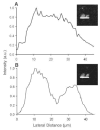Mass spectrometric imaging of highly curved membranes during Tetrahymena mating
- PMID: 15232100
- PMCID: PMC2833272
- DOI: 10.1126/science.1099791
Mass spectrometric imaging of highly curved membranes during Tetrahymena mating
Abstract
Biological membrane fusion is crucial to numerous cellular events, including sexual reproduction and exocytosis. Here, mass spectrometry images demonstrate that the low-curvature lipid phosphatidylcholine is diminished in the membrane regions between fusing Tetrahymena, where a multitude of highly curved fusion pores exist. Additionally, mass spectra and principal component analysis indicate that the fusion region contains elevated amounts of 2-aminoethylphosphonolipid, a high-curvature lipid. This evidence suggests that biological fusion involves and might in fact be driven by a heterogeneous redistribution of lipids at the fusion site.
Figures



References
Publication types
MeSH terms
Substances
Grants and funding
LinkOut - more resources
Full Text Sources
Other Literature Sources

